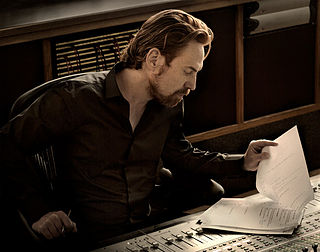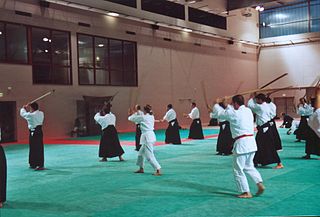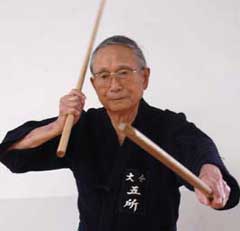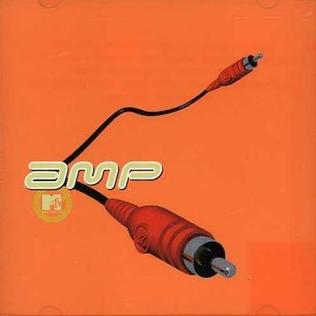
Miyamoto Musashi, also known as Shinmen Takezō, Miyamoto Bennosuke or, by his Buddhist name, Niten Dōraku, was a Japanese swordsman, philosopher, strategist, writer and rōnin. Musashi, as he was often simply known, became renowned through stories of his unique double-bladed swordsmanship and undefeated record in his 61 duels. He is considered a Kensei, a sword-saint of Japan. He was the founder of the Niten Ichi-ryū, or Nito Ichi-ryū, style of swordsmanship, and in his final years authored The Book of Five Rings and Dokkōdō. Both documents were given to Terao Magonojō, the most important of Musashi's students, seven days before Musashi's death. The Book of Five Rings deals primarily with the character of his Niten Ichi-ryū school in a concrete sense, i.e., his own practical martial art and its generic significance; The Path of Aloneness, on the other hand, deals with the ideas that lie behind it, as well as his life's philosophy in a few short aphoristic sentences. The Miyamoto Musashi Budokan training centre, located in Ōhara-chō (Mimasaka), Okayama prefecture, Japan was erected to honor his name and legend.

Rupert Parkes, known as Photek, is a Los Angeles–based, British record producer, film and TV composer, and electronic music DJ. Photek was born and raised in Ipswich, Suffolk, England.

Kenjutsu (剣術) is the umbrella term for all (ko-budō) schools of Japanese swordsmanship, in particular those that predate the Meiji Restoration. Some modern styles of kendo and iaido that were established in the 20th century also included modern forms of kenjutsu in their curriculum. Kenjutsu, which originated with the samurai class of feudal Japan, means "methods, techniques, and the art of the Japanese sword". This is opposed to kendo, which means "the way of the sword" and uses a bamboo sword (shinai) and protective armour (bōgu).
Kukishin-ryū (九鬼神流), originally "Nine Gods Divine School" is a Japanese martial art allegedly founded in the 14th century CE by Kuki Yakushimaru Ryūshin. It is a sōgō bujutsu, meaning that it teaches several different weapons/arts such as taijutsu, bōjutsu, naginatajutsu, kenpō, hanbōjutsu, sōjutsu and heiho. Kukishin-ryū and its founder are listed in the Bugei Ryūha Daijiten or "The Encyclopedia of Martial Art Schools", a record of modern (gendai) and old lineage (koryū) Japanese martial schools.

The Book of Five Rings is a text on kenjutsu and the martial arts in general, written by the Japanese swordsman Miyamoto Musashi around 1643. There have been various translations made over the years, and it enjoys an audience considerably broader than only that of martial artists and people across East Asia: for instance, some foreign business leaders find its discussion of conflict and taking the advantage to be relevant to their work in a business context. The modern-day Hyōhō Niten Ichi-ryū employs it as a manual of technique and philosophy.

Gōjū-ryū (剛柔流), Japanese for "hard-soft style", is one of the main traditional Okinawan styles of karate, featuring a combination of hard and soft techniques. Both principles, hard and soft, come from the famous martial arts book used by Okinawan masters during the 19th and 20th centuries, the Bubishi. Gō, which means hard, refers to closed hand techniques or straight linear attacks; jū, which means soft, refers to open hand techniques and circular movements. Gōjū-ryū incorporates both circular and linear movements into its curriculum, combining hard striking attacks such as kicks and close hand punches with softer open hand circular techniques for attacking, blocking, and controlling the opponent, including joint locks, grappling, takedowns, and throws.
Musō Shinden-ryū (夢想神伝流) is a style of sword-drawing art (iaido) founded by Nakayama Hakudō (中山博道) in 1932. Nakayama Hakudō studied under Hosokawa Yoshimasa, a master of the Shimomura branch (下村派) of Hasegawa Eishin-ryū, and Morimoto Tokumi, a fellow student of Ōe Masaji of the Tanimura branch (谷村派). The name Musō Shinden-ryū most likely comes from the name given to the Shimomura branch by Hosokawa, Musō Shinden Eishin-ryū (無雙神傳英信流).
YoshinkanAikido is a style of aikido that developed after World War II in the Yoshinkan Dojo of Gozo Shioda (1915–1994). Yoshinkan Aikido is often called the "hard" style of aikido because the training methods are a product of Shioda's grueling life before the war. Shioda named his dojo "Yoshinkan" after a dojo of the same name that was built by his father, a physician, who wanted to improve both physical and spiritual health. The Yoshinkan style is currently the second largest aikido organization worldwide.

Aiki-ken is the name given specifically to the set of Japanese sword techniques practiced according to the principles of aikido, taught first by Morihei Ueshiba, then further developed by Morihiro Saito, one of Ueshiba's most prominent students. Currently, Iwama Shin-Shin Aiki Shuren-kai is the main proponent organization.
Musō Jikiden Eishin-ryū is a Japanese sword art school and one of the most widely practiced schools of iai in the world. Often referred to simply as "Eishin-ryū," it claims an unbroken lineage dating back from the sixteenth century to the early 20th century. 17th undisputed headmaster, Oe Masaji, awarded at least 16 licenses of full transmission, resulting in the school fracturing into multiple legitimate branches.
Niten Ichi-ryū (二天一流), which can be loosely translated as "the school of the strategy of two heavens as one", is a koryū, transmitting a style of classical Japanese swordsmanship conceived by the warrior Miyamoto Musashi. Hyōhō Niten Ichi-ryū is mainly known for the two-sword—katana and wakizashi—kenjutsu techniques Musashi called Niten Ichi or Nitō Ichi.
Yagyū Shinkage-ryū (柳生新陰流) is one of the oldest Japanese schools of swordsmanship (kenjutsu). Its primary founder was Kamiizumi Nobutsuna, who called the school Shinkage-ryū. In 1565, Nobutsuna bequeathed the school to his greatest student, Yagyū Munetoshi, who added his own name to the school. Today, the Yagyū Shinkage-ryū remains one of the most renowned schools of Japanese swordsmanship. Its name roughly means Yagyū New Shadow School.

Gosoku-ryū (剛速流) is a style of karate which was founded by Takayuki Kubota. Gosoku stands for hard and fast, which suggests a combination of techniques both from the fast and dynamic Shōtōkan style as well as from the strength-focused Gōjū-ryū style.

"Every Day Is Exactly the Same" is the third single by American industrial rock band Nine Inch Nails from their album With Teeth. It is the twenty-first official Nine Inch Nails release. The commercial single was released on April 4, 2006 as an EP.
Form & Function Vol. 2 is Photek's fourth studio album. It is a collection of dubplates and remixes plus some exclusives. It was released September 24, 2007 on the Sanctuary Records label. There was also a vinyl release of the LP for DJs.

Shinkage-ryū (新陰流) meaning "new shadow school", is a traditional school (ko-budō) of Japanese martial arts, founded by Kamiizumi Ise-no-Kami Nobutsuna in the mid-sixteenth century. Shinkage-ryū is primarily a school of swordsmanship, and is a synthesis of Nobutsuna's studies in the school of Kage-ryū (Aizu). Shinkage-ryu can also refer to Kashima derived schools such as Kashima Shinden Jikishinkage Ryu and Kashima Shin Ryu.

The Gosho Ha Hyōhō Niten Ichi-ryū (五所派兵法二天一流) was one of the branches of the Niten Ichi-ryū, the Kenjutsu school created by Miyamoto Musashi, under the supervision of Gosho Motoharu, Shihan of the 9th generation. Since April 2007 was reintegrated with the seito under Yoshimoti Kiyoshi, 12th successor of Hyōhō Niten Ichi-ryū and 10th successor of Gosho-ha Hyōhō Niten Ichi-ryū.

MTV's Amp is a 1997 electronic album produced by the late-night show, MTV's Amp. It features many of the bigger hits in America, including tracks from the Chemical Brothers and Crystal Method.
This is the discography for British electronic musician Photek.










